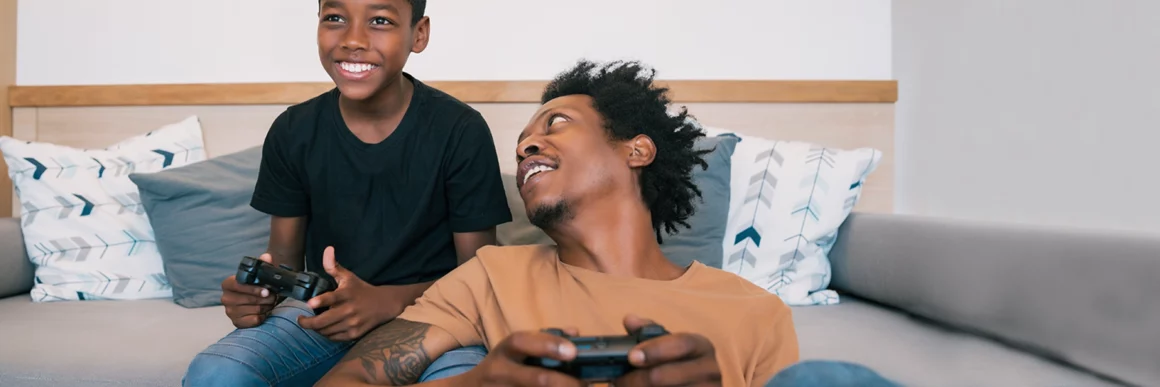This article was originally written for the National Center for Missing & Exploited Children (NCMEC). Christy Keating, J.D. provided additional information and background.
Online gaming has become increasingly popular with young people and adults of all ages and genders in recent years. There is a vast array of game-types available online ranging from massively multiplayer online games (MMOG) (an online game with large numbers of players, often playing in a common open world, enabling players to cooperate and compete with each other) to digital arcades and sports games. Gaming has been shown to have positive effects on social skills and problem solving, but it is not an activity completely without risks.
The Issue With Online Gaming
It can be hard for adults to supervise online gaming. There are thousands of online games and apps, making it hard to know exactly what young people are playing. In addition, young people can play from anywhere thanks to mobile gaming devices, smartphones, and tablets.
Games can also have confusing or inappropriate content for kids. Some have adult language or are violent or sexual. Others have advertisements that let young people make purchases without their caregiver’s authorization.
Many online games have features that allow players to talk or Instant Message (IM) with each other. Some of these players may:
- Gather sensitive information like passwords and credit card numbers by scamming children or hacking directly into their accounts.
- Engage in the online enticement of children by having sexual conversations, requesting sexual images or, more rarely, asking children to meet offline. They may even try to get children to share sexual images by sharing their own images first.
Online Gaming: By the Numbers

- 72% of teens (ages 13-17), both male and female, play video games[1]
- More than half of those teens said they have made new friends online
- NCMEC analysis of the CyberTipline reports has found that gaming platforms are more often used in the online enticement of young boys than any other group[2]
How to Help Keep Kids Safe While Gaming
Your involvement is critical when it comes to helping young people play online games more safely. Take an active interest in the games that your young person plays and want to buy. You can research games’ ratings and content on Entertainment Software Ratings Board (ESRB), which rates thousands of games each year.
BLOOM Tip > You can also visit ESRB to learn about how to set parental controls, view a family discussion guide, including conversation starters, and download their app.
NCMEC suggests you familiarize yourself with what safety features are available on the gaming equipment that your child uses — a headset may have voice-masking features, for example.
- Keep gaming consoles in an easy-to-supervise location and be aware of other places where your young person may be accessing games.
- Tell your young person never to give out personal information while gaming or agree to meet anyone outside of the game.
- Set rules about how long your young person may play, what types of games are appropriate, and who else may participate.
- Have your young person check with you before using a credit or debit card online.
- Check to see if the games your young person plays have reporting features or moderators. Review these features with your young person. Remember, you can also report inappropriate online interactions with kids to CyberTipline.org.
Setting Boundaries Around Game Usage
When it comes to managing a young person’s game usage, it is far easier to establish healthy boundaries and rules before they get their first gaming console rather than after, but this is also a case of “better late than never.”
If you have never set rules around these game usage, or if you are observing any of these “red flag” behaviors in your tween or teen, it may be time to establish and reinforce some new guidelines.
- A decline in hygiene and personal self-care (e.g., brushing teeth, dressing for the day, brushing hair)
- Lying about gaming usage
- Difficulty completing obligations at work, school, or home
- Isolation from loved ones (e.g., neglecting family, friends, or activities they used to enjoy outside online activities)
- Reducing or limiting participation in previously enjoyed activities
- Mood swings related to gaming usage or behavior changes (getting angry, upset, or anxious) when they are not able to play
- Feeling disconnected and withdrawn
- Demonstrating a need to game and not being able to set limits for gaming usage
How to Help Maintain Gaming & Life Balance
Establish and Post Gaming Rules
Work with your young person to establish reasonable gaming rules involving:
- Limits on usage time, like when and how long they may play
- Limits on the types of age appropriate games they are allowed to play at home or when playing elsewhere
- Setting limits through parental controls to ensure safety and privacy
- Not gaming with someone they don’t know personally
- Only playing authorized games
- No in app purchases

Be Consistent With Game Rule Enforcement
Once the household gaming rules are established, achieving consistency will be the key to maintaining a harmonious gaming relationship with your young person. Be careful not to allow extra time, unless time is earned.
If extra time is granted due to gaming with a friend, ensure your young person recognizes that this is granted on a case-by-case basis. Lastly, do not bend the rules around the types of games played. Have consequences in place if the gaming rules are not followed.
Model Screen Time Behavior
Set an example by limiting your own usage and substituting digital use for other activities. Tell your young person how too much time on screens makes you feel so that they may recognize similar symptoms in themselves.
Remember To …
- Keep an eye on gaming usage
- Keep an eye out on which games they are using
- Encourage gaming detox by choosing a certain number of days per week or a period of time that doesn’t involve gaming
- Search game ratings and set parental controls (learn more by visiting ESRB)

How to Talk to Kids About Online Gaming Safety
This information has been provided by BLOOM’s trusted partner: National Center For Missing and Exploited Children. Use these tips to help your young person game more safely online:
Ask
- What are your favorite games right now? Would you show me how they’re played? Could I play with you?
- Have you ever been cyberbullied while gaming? What did you do?
- Do you know what information is OK to share about yourself while gaming?
- Who do you play online games with? What are their usernames?
- Has anyone talked about sex while you were gaming or asked you to send pictures of yourself?
- Other than at home, where else do you play online games? Do you play on your phone? At friends’ homes?
Reinforce
- It is important to play games that are age-appropriate. Ratings sites like ESRB.org and CommonSenseMedia.org can help you decide if a game is appropriate.
- Being truthful about age is important as it often disables features that may put youth at risk and enables certain safety protocols to make sure the gaming experience is safer and fun for young users.
- Keep personal information private. Remind young people not to share information like credit card or phone numbers.
Best Gaming Consoles for Young Persons
Common Sense Media and ESRB.org are trusted resources when it comes to researching and rating games. Learn more about what CommonSenseMedia.org and ESRB.org recommends for gaming consoles.
Parts of this article was originally published on the National Center for Missing & Exploited Children and only minimally edited for clarity. Other sections were added by the BLOOM team with our writer, Christy Keating, J.D. Read the original article by NCMEC in its original publication.
[1] Lenhart, A., Smith, A.., Anderson, M., Duggan, M., Perrin, A., “Teens, Technology and Friendships.” Pew Research Center, August, 2015. http://www.pewinternet.org/2015/08/06/teens-technology-and-friendships/[2] http://www.missingkids.org/content/dam/pdfs/ncmec-analysis/Online%20Enticement%20Pre-Travel1.pdf
